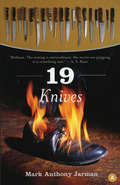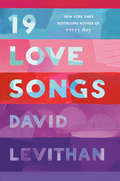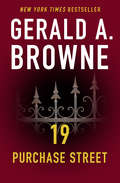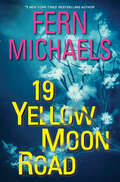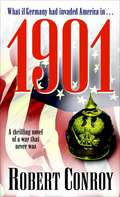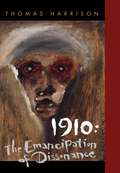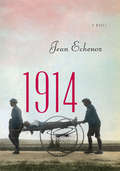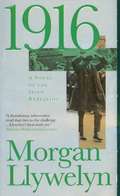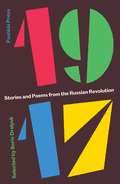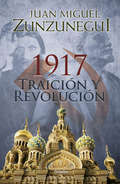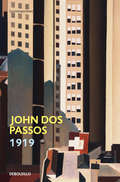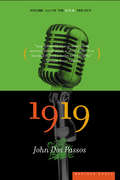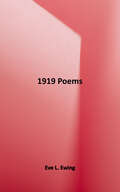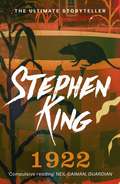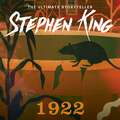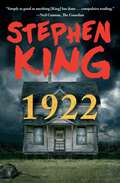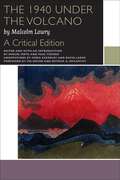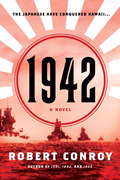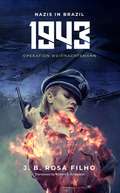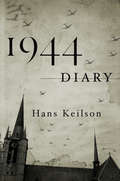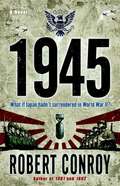- Table View
- List View
19 kamera
by Cristina Fernández Blanco Jon ArretxeTrama paralelo batzuek osatzen dute umorea eta gordintasuna konbinatzen dituen nobela beltz hau: Palankako klub bateko prezio susmagarriak, trafikatzaileen arteko istiluak, adin txikiko prostituta baten desagerpena, kaputxadun talde baten jipoi eta hilketak... Dena dela, nobelako ardatz nagusia Toure da, Bilboko San Frantzisko auzoan bizi den etorkin afrikarra. Ogibidea bilatzen behartuta, gezurrezko igarle gisa saiatuko da lehenik eta, pixkanaka, kasu eta proposamen bitxiak sortzen joango zaizkio.
19 Knives
by Mark JarmanWith characters ranging from the desperate to the obsessive to the wildly comic, Mark Anthony Jarman's 19 Knives employs dazzling linguistic verve and staggering metaphoric powers in every sentence. But Jarman doesn't just write about people, he puts us in their skin so that we feel their frailty and courage. No other contemporary Canadian short-story writer slices up the imaginative excitement, cultural hybridity, and Joycean play of language we see in 19 Knives. With one of the stories shortlisted for the U.S.'s prestigious O. Henry Prize and several others having won prizes or been published in magazines and journals across North America, this collection brings a major fiction writer to the fore.
19 Love Songs
by David LevithanThe New York Times bestselling author of Every Day, Someday, and Two Boys Kissing is back with a short story collection about love--perfect for Valentine's Day or year-round reading! <P><P>A resentful member of a high school Quiz Bowl team with an unrequited crush. A Valentine's Day in the life of Every Day's protagonist "A." <P><P>A return to the characters of Two Boys Kissing.19 Love Songs, from New York Times bestselling author David Levithan, delivers all of these stories and more. <P><P>Born from Levithan's tradition of writing a story for his friends each Valentine's Day, this collection brings all of them to his readers for the first time. With fiction, nonfiction, and a story in verse, there's something for every reader here. Witty, romantic, and honest, teens (and adults) will come to this collection not only on Valentine's Day, but all year round.
19 Purchase Street
by Gerald A. BrowneIn Gerald A. Browne&’s spellbinding New York Times bestseller, a man bent on vengeance infiltrates a cabal of blue-blooded bankers that have taken over the Mafia In a quiet suburb of New York City, a mansion on a gated estate houses one of the most powerful crime syndicates in the United States—an elite Mafia whose dons belong to the finest families that the WASP establishment has to offer. Millions of dollars flow in and out of 19 Purchase Street, toted by bagmen who gladly risk everything to share in the syndicate&’s profits. Nothing disrupts operations—until a courier gets a dangerous idea. To avenge a loved one&’s death, Drew Gainer joins the money-laundering scheme, plotting a billion-dollar heist with the help of a beautiful, daring woman and pitting himself against a ruthless opponent. From New York to Paris to Zurich, Gainer risks his life to become the winner who takes all. But who is really conning whom?
19 Yellow Moon Road: An Action-Packed Novel of Suspense (Sisterhood #33)
by Fern MichaelsA thrilling new book in the wildly popular series from the author of Hidden, legendary #1 New York Times bestseller Fern Michaels! The Sisterhood is reuniting to investigate The Haven, a suspicious spiritual organization that&’s more dangerous cult than caring commune… Maggie Spritzer&’s nose for a story doesn&’t just make her a top-notch newspaper editor, it also tells her when to go the extra mile for a friend. When she gets a strange message from her journalism pal, Gabby Richardson, Maggie knows her services are needed. Gabby has become involved with The Haven, a commune that promises to guide its members toward a more spiritually fulfilling life. But Gabby&’s enthusiasm has turned to distrust ever since she was refused permission to leave the compound to visit her sick mother. Maggie wants to learn more about The Haven, and the Sisterhood is eager to help. It turns out The Haven&’s founders are the sons of a disgraced Chicago businessman in prison for running a Ponzi scheme. They also have connections to a Miami billionaire with dubious sidelines. Soon, the Sisterhood gang embark on a search—and uncover a web of crime that runs deeper and higher than they ever imagined. And they&’ll need all their special skills to bring it down… Praise for Fern Michaels&“Michaels&’s highly developed skills as a storyteller are evident in the affable characters [and] suspenseful plot.&” —Publishers Weekly on Deep Harbor
1901: A Thrilling Novel of a War that Never Was
by Robert ConroyThe year is 1901. Germany's navy is the second largest in the world; their army, the most powerful. But with the exception of a small piece of Africa and a few minor islands in the Pacific, Germany is without an empire. Kaiser Wilhelm II demands that the United States surrender its newly acquired territories: Guam, Puerto Rico, Cuba, and the Philippines. President McKinley indignantly refuses, so with the honor and economic future of the Reich at stake, the Kaiser launches an invasion of the United States, striking first on Long Island. Now the Americans, with their army largely disbanded, must defend the homeland. When McKinley suffers a fatal heart attack, the new commander in chief, Theodore Roosevelt, rallies to the cause, along with Confederate general James Longstreet. From the burning of Manhattan to the climactic Battle of Danbury, American forces face Europe's most potent war machine in a blazing contest of will against strength.
1910: The Emancipation of Dissonance
by Thomas HarrisonThe year 1910 marks an astonishing, and largely unrecognized, juncture in Western history. In this perceptive interdisciplinary analysis, Thomas Harrison addresses the extraordinary intellectual achievement of the time. Focusing on the cultural climate of Middle Europe and paying particular attention to the life and work of Carlo Michelstaedter, he deftly portrays the reciprocal implications of different discourses—philosophy, literature, sociology, music, and painting. His beautifully balanced and deeply informed study provides a new, wider, and more ambitious definition of expressionism and shows the significance of this movement in shaping the artistic and intellectual mood of the age.1910 probes the recurrent themes and obsessions in the work of intellectuals as diverse as Egon Schiele, Georg Trakl, Vasily Kandinsky, Georg Lukàcs, Georg Simmel, Dino Campana, and Arnold Schoenberg. Together with Michelstaedter, who committed suicide in 1910 at the age of 23, these thinkers shared the essential concerns of expressionism: a sense of irresolvable conflict in human existence, the philosophical status of death, and a quest for the nature of human subjectivity. Expressionism, Harrison argues provocatively, was a last, desperate attempt by the intelligentsia to defend some of the most venerable assumptions of European culture. This ideological desperation, he claims, was more than a spiritual prelude to World War I: it was an unheeded, prophetic critique.
1914
by Linda Coverdale Jean EchenozFive Frenchmen go off to war, two of them leaving behind a certain young woman who longs for their return. But the main character in 1914 is the Great War itself. Jean Echenoz, the multi-award-winning French literary magician whose work has been compared to Joseph Conrad and Lawrence Sterne, has brought that deathtrap back to life, leading us gently from a balmy summer day deep into the insatiable-and still unthinkable-carnage of trench warfare.With the delicacy of a miniaturist and with irony both witty and clear-eyed, the author offers us an intimate epic with the atmosphere of a classic movie: in the panorama of a clear blue sky, a biplane spirals suddenly into the ground; a tardy piece of shrapnel shears the top off a man's head as if it were a soft-boiled egg; we dawdle dreamily in a spring-scented clearing with a lonely shell-shocked soldier strolling innocently to a firing squad ready to shoot him for desertion.But ultimately, the grace notes of humanity in 1914 rise above the terrors of war in this beautifully crafted tale that Echenoz tells with discretion, precision, and love.
1916
by Morgan LlywelynHistorical novel of the struggle for Irish independence, seen through the eyes of a young Irish partisan.
1916: A Novel of the Irish Rebellion
by Morgan LlywelynAt age fifteen, Ned Halloran lost both of his parents--and almost his own life--when the Titanic sank. Determined to keep what little he has, he returns to his homeland of Ireland and enrolls at Saint Edna's school in Dublin. Saint Edna's headmaster is the renowned scholar and poet, Patrick Pearse--who is soon to gain greater fame as a rebel and patriot. Ned becomes deeply involved with the growing revolution . . . and the sacrifices it will demand.Through Ned's eyes, Morgan Llywelyn's 1916 examines the Irish fight for freedom--inspired by poets and schoolteachers, fueled by a desperate desire for independence, and played out in the historic streets of Dublin against the background of World War I. It is a story of the brave men and heroic women who, for a few unforgettable days, managed to hold out against the might of the British Empire.
1917: Stories and Poems from the Russian Revolution
by Boris Dralyuk Various1917: Stories and Poems from the Russian Revolution is a collection of literary responses to one of the most cataclysmic events in modern world history, which exposes the immense conflictedness and doubt, conviction and hope, pessimism and optimism which political events provoked among contemporary writers - sometimes at the same time, even in the same person. This dazzling panorama of thought, language and form includes work by authors who are already well known to the English-speaking world (Bulgakov, Pasternak, Akhmatova, Mayakovsky), as well as others, whose work we have the pleasure of encountering here for the very first time in English. Edited by Boris Dralyuk, the acclaimed translator of Isaac Babel's Red Cavalry (also published by Pushkin Press), 1917 includes works by some of the best Russian writers - some already famous in the English-speaking world, some published here for the very first time. It is an anthology for everyone: those who are coming to Russian literature for the first time, those who are already experienced students of it, and those who simply want to know how it felt to live through this extreme period in history.POETRY: * Marina Tsvetaeva, 'You stepped from a stately cathedral ', 'Night. - Northeaster. - Roar of soldiers. - Roar of waves.' * Zinaida Gippius, 'Now', 'What have we done to it?', '14 December 1917' * Osip Mandelstam, 'In public and behind closed doors' * Osip Mandelstam, 'Let's praise, O brothers, liberty's dim light' * Anna Akhmatova, 'When the nation, suicidal' * Boris Pasternak, 'Spring Rain' * Mikhail Kuzmin, 'Russian Revolution' * Sergey Esenin, 'Wake me tomorrow at break of day' * Mikhail Gerasimov, 'I forged my iron flowers' * Vladimir Kirillov, 'We' * Aleksey Kraysky, 'Decrees' * Andrey Bely, 'Russia' * Alexander Blok, 'The Twelve' * Titsian Tabidze, 'Petersburg' * Pavlo Tychyna, 'Golden Humming' * Vladimir Mayakovsky, 'Revolution: A Poem-Chronicle', 'To Russia', 'Our March' PROSE: * Alexander Kuprin, 'Sashka and Yashka' * Valentin Kataev, 'The Drum' * Aleksandr Serafimovich, 'How He Died' * Dovid Bergelson, 'Pictures of the Revolution' * Teffi, 'A Few Words About Lenin', 'The Guillotine' * Vasily Rozanov, from 'Apocalypse of Our Time' * Aleksey Remizov, 'The Lay of the Ruin of Rus'' * Yefim Zozulya, 'The Dictator: A Story of Ak and Humanity' * Yevgeny Zamyatin, 'The Dragon' * Aleksandr Grin, 'Uprising' * Mikhail Prishvin, 'Blue Banner' * Mikhail Zoshchenko, 'A Wonderful Audacity' * Mikhail Bulgakov, 'Future Prospects'From the Trade Paperback edition.
1917. Traición y revolución
by Juan Miguel ZunzuneguiUna historia del amor separado por las ideologías y la única revolución que nunca ha triunfado. Europa se desangra en la Primera Guerra Mundial, millones de cadáveres rusos y alemanes yacen en el frente oriental, mientras los poderosos se reparten el mundo. Desde Londres hasta Constantinopla, y de San Petersburgo a Berlín, los ejércitos, espías, revolucionarios y agentes secretos destruyen los antiguos imperios y forjan los cimientos de un nuevo mundo. En medio de la guerra de Europa y de la revolución soviética, el misterioso agente norteamericano John Mann investiga la trama de toda una conspiración que involucra la muerte del misterioso Rasputín, la caída del Zar, las maquinaciones de Stalin y las estrategias de Trotsky, el reparto de Medio Oriente, a los árabes y turcos, a los bolcheviques y alemanes, y al arma más poderosa del Kaiser en su guerra contra el Imperio Ruso: Vladimir Lenin. La historia quecomienza en 1917 termina el 9 de noviembre de 1989 con la caída del Muro de Berlín. Anastasia y Konstantin, dos sobrevivientes de la revolución soviética, separados por el muro, narran su versión de los hechos mientras buscan reencontrarse. Una historia del amor separado por las ideologías, de los eternos sueños frustrados de la humanidad, y de la única revolución que nunca ha triunfado.
1919: The U. S. A. Trilogy (Trilogía USA #Volumen 2)
by John Dos PassosSegunda entrega de la Trilogía USA: un retrato incomparable de América desde el nacimiento del siglo hasta la Depresión de 1929. El estallido de la Primera Guerra Mundial y la participación de Estados Unidos cobran protagonismo en esta novela -segunda parte de la Trilogía USA- que conserva parte de los personajes que pululaban por Paralelo 42, el mismo vigor narrativo y la voz histórica de Woodrow Wilson, Theodore Roosevelt o el Soldado Desconocido para contarnos cómo la avaricia de la sociedad estadounidense de los felices años 20 no se detiene ante nada. Reseña:«Considero a John Dos Passos el más grande escritor de nuestro tiempo.»Jean-Paul Sartre
1919: The Complete Trilogy [the 42nd Parallel, 1919, And The Big Money] (U.S.A. Trilogy #2)
by John Dos Passos&“A Depression-era novel about American tumult has—perhaps unsurprisingly—aged quite well.&”—The New YorkerIn 1919, the second volume of his U.S.A. trilogy, John Dos Passos continues his &“vigorous and sweeping panorama of twentieth-century America&” (Forum).Employing a host of experimental devices that would inspire a whole new generation of writers to follow, Dos Passos captures the many textures, flavors, and background noises of the era with a cinematic touch and unparalleled nerve.1919 opens to find America and the world at war, and Dos Passos&’s characters, many of whom we met in the first volume, are thrown into the snarl. We follow the daughter of a Chicago minister, a wide-eyed Texas girl, a young poet, and a Jewish radical, and we get glimpses of Woodrow Wilson, Theodore Roosevelt, and the Unknown Soldier.Named one of the Modern Library&’s 100 best English-language novels of the twentieth century, &“U.S.A. is a masterpiece&” (Tim O&’Brien) and 1919 is an unforgettable chapter in the saga. &“It&’s the kind of book a reader never forgets.&”—Chicago Daily Tribune
1919
by Eve L. EwingThe Chicago Race Riot of 1919, the most intense of the riots that comprised the "Red Summer" of violence across the nation's cities, is an event that has shaped the last century but is widely unknown. <p><p>In 1919, award-winning poet Eve L. Ewing explores the story of this event—which lasted eight days and resulted in thirty-eight deaths and almost 500 injuries—through poems recounting the stories of everyday people trying to survive and thrive in the city. Ewing uses speculative and Afrofuturist lenses to recast history and illuminate the thin line between the past and the present. <p><p>Eve L. Ewing is a writer and an assistant professor at the University of Chicago School of Social Service Administration. She is the author of Electric Arches and Ghosts in the Schoolyard: Racism and School Closings on Chicago's South Side.
1921 The Great Novel of the Irish Civil War
by Morgan LlywelynNovel about the beginning of Irish independence from England, and the subsequent civil war, seen through the eyes of a fictional journalist. Some violence.
1922
by Stephen KingThe chilling novella featured in Stephen King's bestselling collection Full Dark, No Stars, 1922 - about a man who succumbs to the violence within - is now available as a stand-alone publication.I believe there is a man inside every man, a strangerSo writes Wilfred James in his confession. It's 1922. Wilfred owns eighty acres of farmland in Nebraska that have been in the family for generations. His wife, Arlette, owns an adjoining one hundred acres.But if Arlette carries out her threat to sell her land to a pig butcher, Wilfred will be forced to sell too. Worse, he'll have to move to the city. But he has a daring plan. It may work if he can persuade his son. A powerful tale of betrayal, murder, madness and rats, 1922 is a breathtaking exploration into the dark side of human nature from the great American storyteller Stephen King. It was adapted into a film from Netflix.
1922
by Stephen KingThe chilling novella featured in Stephen King's bestselling collection Full Dark, No Stars, 1922 - about a man who succumbs to the violence within - is now available as a stand-alone publication.I believe there is a man inside every man, a strangerSo writes Wilfred James in his confession. It's 1922. Wilfred owns eighty acres of farmland in Nebraska that have been in the family for generations. His wife, Arlette, owns an adjoining one hundred acres.But if Arlette carries out her threat to sell her land to a pig butcher, Wilfred will be forced to sell too. Worse, he'll have to move to the city. But he has a daring plan. It may work if he can persuade his son. A powerful tale of betrayal, murder, madness and rats, 1922 is a breathtaking exploration into the dark side of human nature from the great American storyteller Stephen King. It was adapted into a film from Netflix.(P) 2010 Simon & Schuster, Inc.
1922
by Stephen KingThe chilling novella featured in Stephen King&’s New York Times bestselling collection Full Dark, No Stars, 1922 is about a man who succumbs to the violence within—setting in motion a grisly train of murder and madness.Wilfred James owns eighty acres of farmland in Nebraska that have been in his family for generations. His wife, Arlette, owns an adjoining one hundred acres. She wants to sell her land but if she does, Wilfred will be forced to sell as well. James will do anything to hold onto his farm, and he'll get his son to go along. Betrayal, murder, madness, rats, 1922 is a breathtaking exploration into the dark side of human nature from the great American storyteller Stephen King.
The 1940 Under the Volcano: A Critical Edition (Canadian Literature Collection)
by Malcolm LowryThe 1940 Under the Volcano—hidden for too long in the shadows of Lowry’s 1947 masterpiece—differs from the latter in significant ways. It is a bridge between Lowry’s 1930s fiction (especially In Ballast to the White Sea) and the 1947 Under the Volcano itself. Joining the recently published Swinging the Maelstrom and In Ballast to the White Sea, The 1940 Under the Volcano takes its rightful place as part of Lowry’s exciting 1930s/early-40s trilogy. Scholars have only recently begun to pay systematic attention to convergences and divergences between this earlier work and the 1947 version. Miguel Mota and Paul Tiessen’s insightful introduction, together with extensive annotations by Chris Ackerley and David Large, reveal the depth and breadth of Lowry’s complex vision for his work. This critical edition fleshes out our sense of the enormous achievement by this twentieth-century modernist.Publié en anglais.
1942: A Novel
by Robert ConroyDecember 7 is "the date which will live in infamy." But now Japan is hatching another, far greater plan to bring America to its knees. . . . The Japanese surprise attack on Pearl Harbor was a resounding success-except for one detail: a second bombing mission, to destroy crucial oil storage facilities, was aborted that day. Now, in this gripping and stunning work of alternate history, Robert Conroy reimagines December 7, 1941, to include the attack the Japanese didn't launch, and what follows is a thrilling tale of war, resistance, sacrifice, and courage. For when Admiral Isoroku Yamamoto sees how badly the United States has been ravaged in a two-pronged strike, he devises another, more daring proposal: an all-out invasion of Hawaii to put a stranglehold on the American Pacific Fleet. Yamamoto's strategy works brilliantly-at first. But a handful of American soldiers and a determined civilian resistance fight back in the face of cruelty unknown in Western warfare. Stateside, a counterassault is planned-and the pioneering MIT-trained aviator Colonel Jimmy Doolittle is given a near-impossible mission with a fleet of seaplanes jury-rigged into bombers. From spies to ordinary heroes and those caught between two cultures at war, this is the epic saga of the Battle of Hawaii-the way it very nearly was. . . .
1943 -- Operation Weihnachtsmann: Nazis in Brazil
by Jb Rosa FilhoSuspenseful novel about attempts of Nazi Abwehr agent to subvert Brazil's valiant efforts in support of the Allied war effort during World War Two -- a little known and much neglected theater of that critically important event.
1944 Diary
by Damion Searls Hans Keilson[1944 Diary] is a deeply personal account, made even more remarkable that it was written during World War II and the horrors of the Holocaust . . . A moving and fascinating read." —Library JournalIn 2010, FSG published two novels by the German- Jewish writer Hans Keilson: Comedy in a Minor Key—written in 1944 while Keilson was in hiding in the Netherlands, first published in German in 1947, and never before in English—and The Death of the Adversary, begun in 1944 and published in 1959, also in German. With their Chekhovian sympathy for perpetrators and bystanders as well as for victims and resisters, Keilson’s novels were, as Francine Prose said on the front page of The New York Times Book Review, “masterpieces” by “a genius” on her list of “the world’s very greatest writers.” Keilson was one hundred years old, alive and well and able to enjoy his belated fame.1944 Diary, rediscovered among Keilson’s papers shortly after his death, covers nine months he spent in hiding in Delft with members of a Dutch resistance group, having an affair with a younger Jewish woman in hiding a few blocks away and striving to make a moral and artistic life for himself as the war and the Holocaust raged around him. For readers familiar with Keilson’s novels as well as those new to his work, this diary is an incomparable spiritual X-ray of the mind and heart behind the art: a record of survival and creativity in what Keilson called “the most critical year of my life.”Offering further insight into Keilson are the sonnets he wrote for his lover, Hanna Sanders, which appear in translation at the back of this volume.
1945: A Novel
by Robert ConroyAmerica has dropped atomic bombs on Hiroshima and Nagasaki.But Japan has only begun to fight. . . .In 1945, history has reached a turning point. A terrible new weapon has been unleashed. Japan has no choice but to surrender. But instead, the unthinkable occurs. With their nation burned and shattered, Japanese fanatics set in motion a horrifying endgame-their aim: to take America down with them. In Robert Conroy's brilliantly imagined epic tale of World War II, Emperor Hirohito's capitulation is hijacked by extremists and a weary United States is forced to invade Japan as a last step in a war that has already cost so many lives. As the Japanese lash out with tactics that no one has ever faced before-from POWs used as human shields to a rain of kamikaze attacks that take out the highest-value target in the Pacific command-the invasion's success is suddenly in doubt. As America's streets erupt in rioting, history will turn on the acts of a few key players from the fiery front lines to the halls of Washington to the shadowy realm of espionage, while a mortally wounded enemy becomes the greatest danger of all.
1945
by Newt Gingrich William R. ForstchenThe year is 1945, In Europe, the Third Reich reigns triumphant. The Soviet Union is a fragment of its former self, and Britain has accepted a dictated armistice. In the Pacific, after a brief, sharp war with Japan, America is the only significant military presence. Now the world's two superpowers eye each other warily across the Atlantic Ocean that grows smaller daily. The Big Show is about to start... Who will win? The Americans with their formidable industrial base and superior logistical techniques-or the Germans with their science fiction super weapons that turn out not to be fictional after all? Only one thing is certain: if America is beaten, this alternate Reich will last a thousand years...

